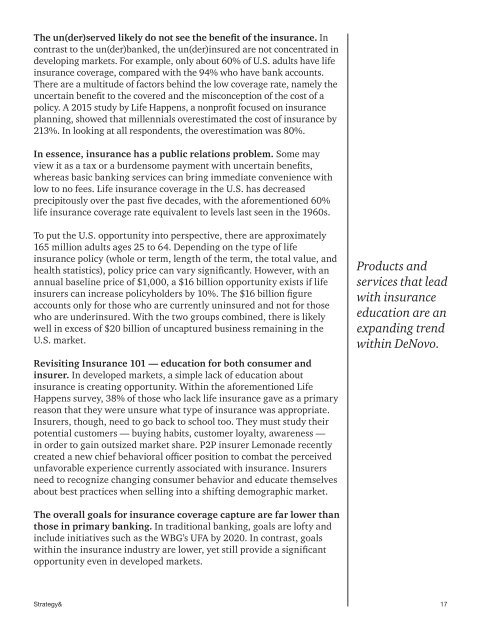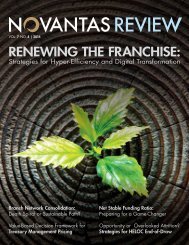The un(der)banked is FinTech’s largest opportunity
DeNovo-Quarterly-Q2-2016.pdf?utm_content=buffer9dd60&utm_medium=social&utm_source=twitter
DeNovo-Quarterly-Q2-2016.pdf?utm_content=buffer9dd60&utm_medium=social&utm_source=twitter
Create successful ePaper yourself
Turn your PDF publications into a flip-book with our unique Google optimized e-Paper software.
<strong>The</strong> <strong>un</strong>(<strong>der</strong>)served likely do not see the benefit of the insurance. In<br />
contrast to the <strong>un</strong>(<strong>der</strong>)<strong>banked</strong>, the <strong>un</strong>(<strong>der</strong>)insured are not concentrated in<br />
developing markets. For example, only about 60% of U.S. adults have life<br />
insurance coverage, compared with the 94% who have bank acco<strong>un</strong>ts.<br />
<strong>The</strong>re are a multitude of factors behind the low coverage rate, namely the<br />
<strong>un</strong>certain benefit to the covered and the m<strong>is</strong>conception of the cost of a<br />
policy. A 2015 study by Life Happens, a nonprofit focused on insurance<br />
planning, showed that millennials overestimated the cost of insurance by<br />
213%. In looking at all respondents, the overestimation was 80%.<br />
In essence, insurance has a public relations problem. Some may<br />
view it as a tax or a burdensome payment with <strong>un</strong>certain benefits,<br />
whereas basic banking services can bring immediate convenience with<br />
low to no fees. Life insurance coverage in the U.S. has decreased<br />
precipitously over the past five decades, with the aforementioned 60%<br />
life insurance coverage rate equivalent to levels last seen in the 1960s.<br />
To put the U.S. opport<strong>un</strong>ity into perspective, there are approximately<br />
165 million adults ages 25 to 64. Depending on the type of life<br />
insurance policy (whole or term, length of the term, the total value, and<br />
health stat<strong>is</strong>tics), policy price can vary significantly. However, with an<br />
annual baseline price of $1,000, a $16 billion opport<strong>un</strong>ity ex<strong>is</strong>ts if life<br />
insurers can increase policyhol<strong>der</strong>s by 10%. <strong>The</strong> $16 billion figure<br />
acco<strong>un</strong>ts only for those who are currently <strong>un</strong>insured and not for those<br />
who are <strong>un</strong><strong>der</strong>insured. With the two groups combined, there <strong>is</strong> likely<br />
well in excess of $20 billion of <strong>un</strong>captured business remaining in the<br />
U.S. market.<br />
Rev<strong>is</strong>iting Insurance 101 — education for both consumer and<br />
insurer. In developed markets, a simple lack of education about<br />
insurance <strong>is</strong> creating opport<strong>un</strong>ity. Within the aforementioned Life<br />
Happens survey, 38% of those who lack life insurance gave as a primary<br />
reason that they were <strong>un</strong>sure what type of insurance was appropriate.<br />
Insurers, though, need to go back to school too. <strong>The</strong>y must study their<br />
potential customers — buying habits, customer loyalty, awareness —<br />
in or<strong>der</strong> to gain outsized market share. P2P insurer Lemonade recently<br />
created a new chief behavioral officer position to combat the perceived<br />
<strong>un</strong>favorable experience currently associated with insurance. Insurers<br />
need to recognize changing consumer behavior and educate themselves<br />
about best practices when selling into a shifting demographic market.<br />
Products and<br />
services that lead<br />
with insurance<br />
education are an<br />
expanding trend<br />
within DeNovo.<br />
<strong>The</strong> overall goals for insurance coverage capture are far lower than<br />
those in primary banking. In traditional banking, goals are lofty and<br />
include initiatives such as the WBG’s UFA by 2020. In contrast, goals<br />
within the insurance industry are lower, yet still provide a significant<br />
opport<strong>un</strong>ity even in developed markets.<br />
Strategy&<br />
17




